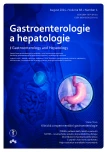Opinion of laypersons, physicians and patients on the new method of achalasia therapy (POEM) – a questionnaire-based study
Authors:
B. Walterová 1,2; R. Doležel 3; O. Ryska 4; J. Juhásová 2; Š. Juhás 2; M. Stefanová 5; J. Špičák 6; J. Martínek 6
Authors‘ workplace:
Gymnázium Jana Palacha, Mělník
1; Ústav živočišné fyziologie a genetiky AV ČR, Liběchov
2; Chirurgická klinika 2. LF UK a ÚVN, Praha
3; Chirurgické oddělení, Nemocnice Hořovice
4; Interní oddělení, Nemocnice Na Františku, Praha
5; Klinika hepatogastroenterologie, IKEM, Praha
6
Published in:
Gastroent Hepatol 2014; 68(4): 288-293
Category:
Clinical and Experimental Gastroenterology: Original Article
Overview
Peroral endoscopic myotomy (POEM) is a new, true endoscopy method of esophageal achalasia therapy. POEM is basically a mini-invasive surgical procedure without any body scars. There is little information on how patients, laypersons and physicians perceive the introduction of this new method for the treatment of achalasia.
Aim:
To obtain opinions from patients, laypersons and physicians on the role of the new POEM method for the treatment of esophageal achalasia.
Methodology:
A questionnaire-based study. One hundred randomly chosen laypersons (without achalasia) were asked specific questions relating to therapy preference were they to become ill with esophageal achalasia. Before filling in the questionnaire they obtained information about the disease and its possible therapies. Similar questionnaires were distributed to 56 physicians of different specializations. Lastly, we questioned 18 achalasia patients who were treated with POEM.
Results:
Laypersons would prefer POEM therapy in 34% (physicians in 36%), laparoscopic myotomy (LHM) in 18% (physicians in 23%) and balloon dilatation or botulotoxin injection in 2% (physicians in 11%) of cases. The majority of laypersons (46%) and a large proportion of physicians (30%) would choose a therapy method after recommendation from their personal physician. In the case of choosing between POEM and LHM only, the majority of laypersons (41%) and physicians (52%) would prefer the POEM therapeutic approach compared to LHM (21% laypersons as well as physicians), but similarly a large proportion of laypersons (38%) and physicians (27%) would respect the recommendation of their personal physician. The main reasons for POEM therapy preference were a “speculative” lower level of invasiveness. The absence of scars was not a very important factor in choosing POEM. The main reasons for LHM preference were better establishment of the method and better knowledge of the risks and long-term results. The possibility of lower gastro-esophageal reflux was not one of the main reasons for selecting LHM therapy. All questioned actual patients who were treated using POEM method before answering would prefer POEM again.
Conclusion:
The majority of respondents (laypersons and physicians) would respect the recommendation of their personal physician or choose the POEM method for their prospective esophageal achalasia therapy. Although not confirmed, the main reason for POEM preference is a belief in its superior safety for the patient; the absence of scars as an advantage of POEM is not so important for the respondents.
Key words:
esophageal achalasia – peroral endoscopic myotomy – laparoscopic myotomy – balloon dilatation
The authors declare they have no potential conflicts of interest concerning drugs, products, or services used in the study.
The Editorial Board declares that the manuscript met the ICMJE „uniform requirements“ for biomedical papers.
Submitted:
13. 6. 2014
Accepted:
4. 8. 2014
Sources
1. Sadowski DC, Ackah F, Jiang B et al. Achalasia: incidence, prevalence and survival. A population-based study. Neurogastroenterol Motil 2010; 22(9): e256–e261. doi: 10.1111/j.1365-2982.2010.01511.x.
2. Campos GM, Vittinghoff E, Rabl C et al. Endoscopic and surgical treatments for achalasia: a systematic review and meta-analysis. Ann Surg 2009; 249(1): 45–57. doi: 10.1097/SLA.0b013e31818e43ab.
3. Krajčíová J, Procházka R, Pintová J et al. Vzácný typ achalázie jícnu III. typu řešený perorální endoskopickou myotomií (POEM). Gastroent Hepatol 2013; 67(4): 261–263.
4. Martínek J, Siroký M, Plottová Z et al. Treatment of patients with achalasia with botulinum toxin: a multicenter prospective cohort study. Dis Esophagus 2003; 16(3): 204–209.
5. Pasricha PJ, Hawari R, Ahmed I et al. Submucosal endoscopic esophageal myotomy: a novel experimental approach for the treatment of achalasia. Endoscopy 2007; 39(9): 761–764.
6. Inoue H, Minami H, Kobayashi Y et al. Peroral endoscopic myotomy (POEM) for esophageal achalasia. Endoscopy 2010; 42(4): 265–271. doi: 10.1055/s-0029-1244080.
7. Martínek J, Rösch T, Špičák J et al. První „POEM“ (perorální endoskopická myotomie) v České republice. Gastroent Hepatol 2012; 66(6): 475–476.
8. Von Renteln D, Fuchs KH, Fockens P et al. Peroral endoscopic myotomy for the treatment of achalasia: an international prospective multicenter study. Gastroenterology 2013; 145(2): 309–311. doi: 10.1053/j.gastro.2013.04.057.
9. Swanström LL, Rieder E, Dunst CM. A stepwise approach and early clinical experience in peroral endoscopic myotomy for the treatment of achalasia and esophageal motility disorders. J Am Coll Surg 2011; 213(6): 751–756. doi: 10.1016/j.jamcollsurg.2011.09.001.
10. Hucl T, Saglova A, Benes M et al. Patient and physician perception of natural orifice transluminal endoscopic appendectomy. World J Gastroenterol 2012; 18(15): 1800–1805. doi: 10.3748/wjg.v18.i15.1800.
11. Varadarajulu S, Tamhane A, Drelichman ER. Patient perception of natural orifice transluminal endoscopic surgery as a technique for cholecystectomy. Gastrointest Endosc 2008; 67(6): 854–860. doi: 10.1016/j.gie.2007.09.053.
12. Wang ZK, Yang YS, Haider KG et al. Chinese physician perception of natural orifice translumenal endoscopic surgery. Dig Dis Sci 2013; 58(8): 2167–2176. doi: 10.1007/s10620-013-2637-6.
13. Meining A, Spaun G, Fernández-Esparrach G et al. NOTES in Europe: summary of the working group reports of the 2012 EURO-NOTES meeting. Endo-scopy 2013; 45(3): 214–217. doi: 10.1055/s-0032-1326205.
14. Inoue H, Santi EG, Onimaru M et al. Submucosal endoscopy: from ESD to POEM and beyond. Gastrointest Endosc Clin N Am 2014; 24(2): 257–264. doi: 10.1016/j.giec.2013.12.003.
Labels
Paediatric gastroenterology Gastroenterology and hepatology SurgeryArticle was published in
Gastroenterology and Hepatology

2014 Issue 4
Most read in this issue
- Efficiency and safety of silymarine in patients with chronic liver diseases – multicenter, prospective, open clinical trial IMHOTEP
- High-resolution anorectal manometry – update in the diagnosis of anorectal disorders
- Diverticular disease
- New development in the treatment of acute and chronic diarrhea in the Czech Republic – Tammex family and Tammex family plus
